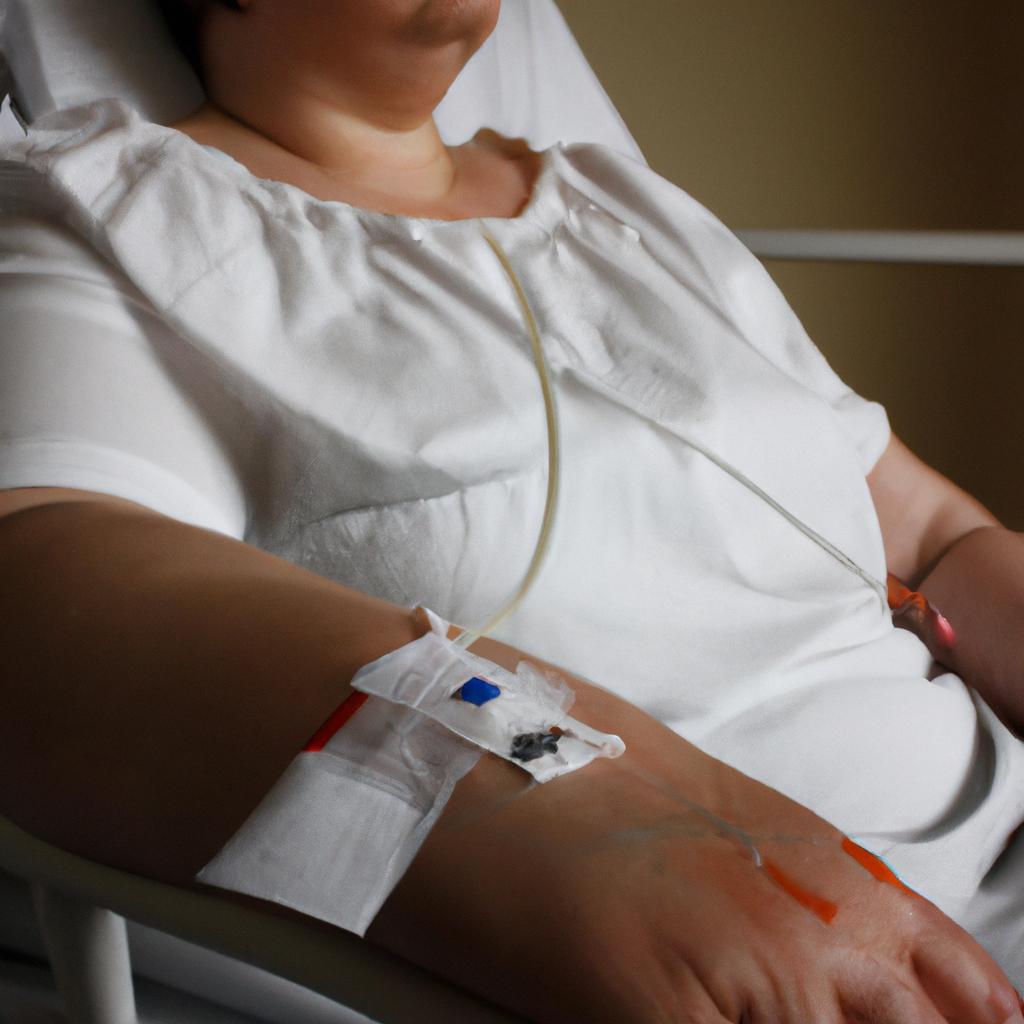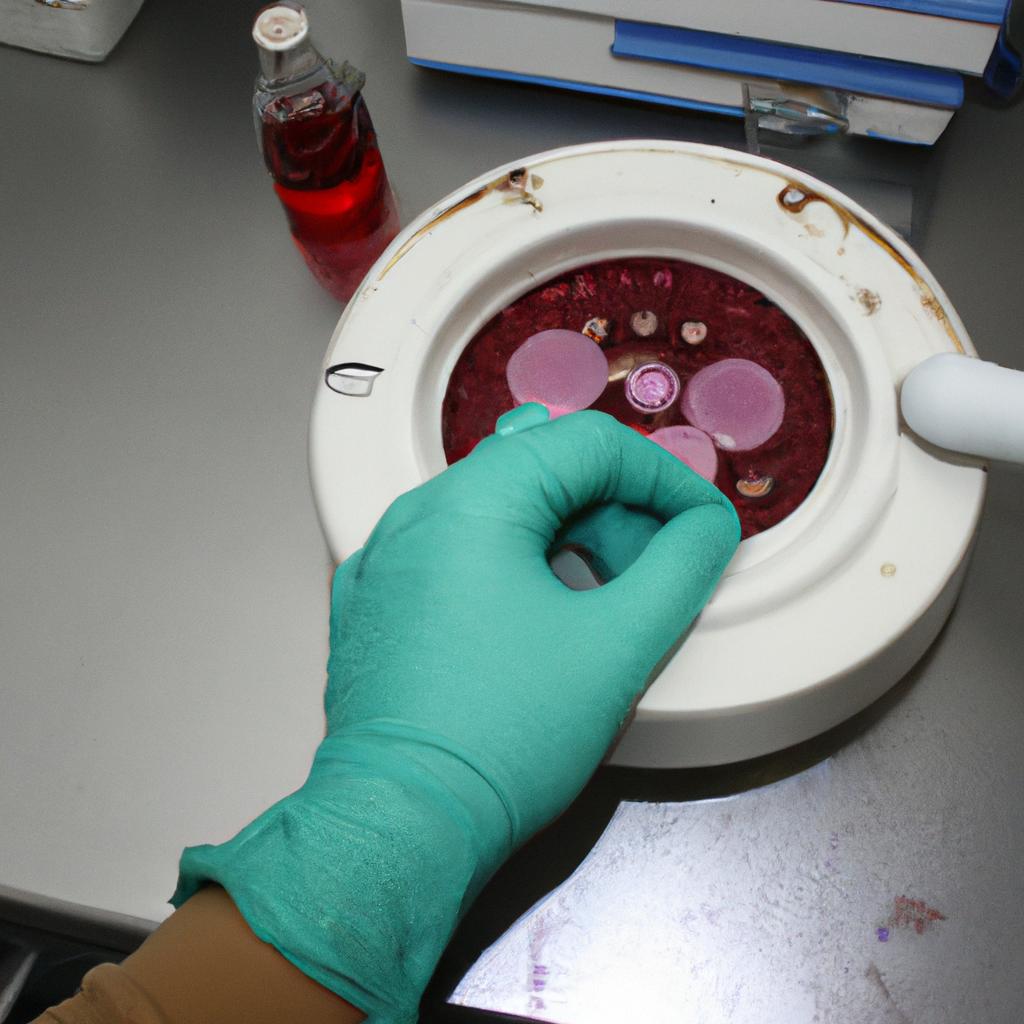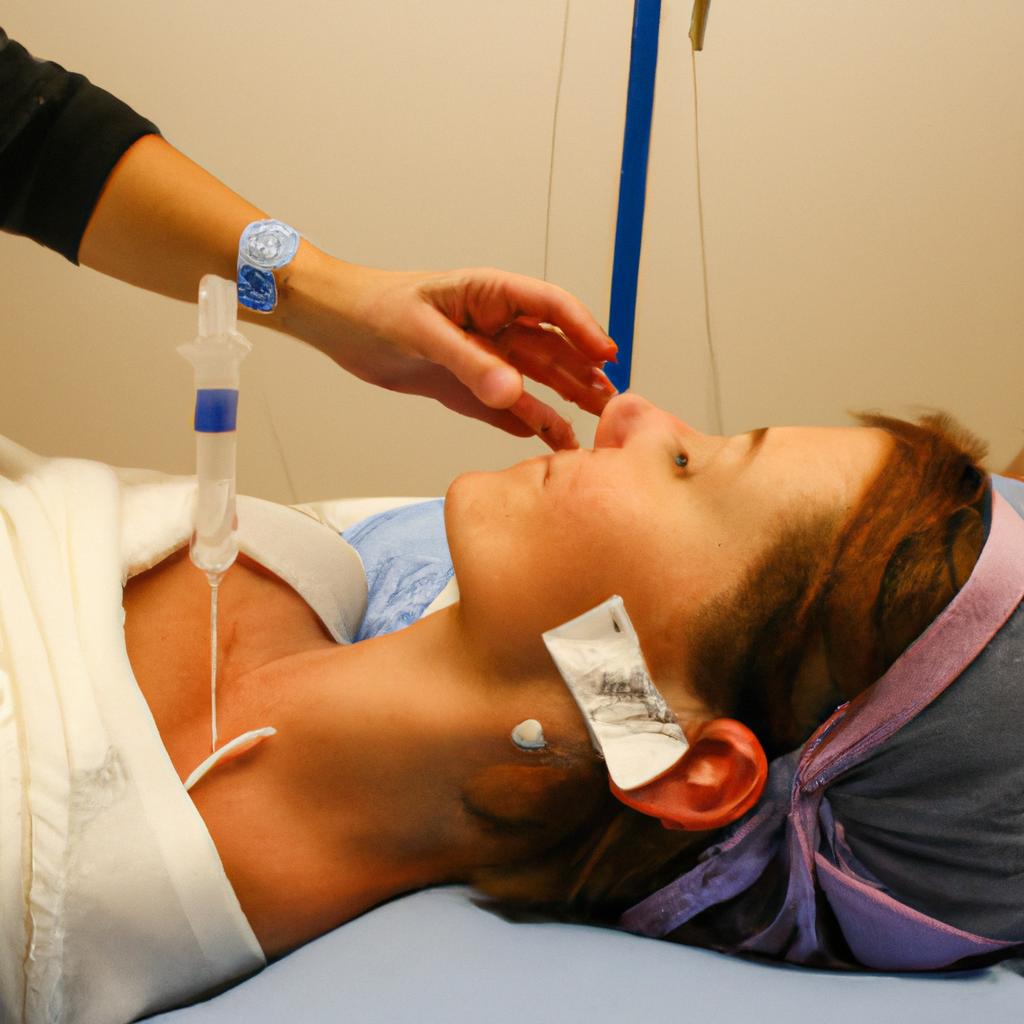Cancer is a widespread and devastating disease that affects millions of individuals worldwide. In recent years, there has been an increasing focus on prevention and early screening as the key strategies to combat this formidable health challenge. By implementing effective preventive measures and ensuring regular screenings, healthcare systems can detect cancer at its earliest stages, when treatment options are more successful and less invasive. For instance, consider the hypothetical case of a 45-year-old woman who undergoes routine mammography screening for breast cancer. Through early detection, any abnormal growth or potential tumor can be identified promptly, allowing for timely interventions that increase the chances of complete recovery.
The significance of prevention in combating cancer cannot be overstated. By adopting healthy lifestyle choices such as maintaining a balanced diet, engaging in regular physical activity, abstaining from tobacco use, and limiting alcohol consumption, individuals can significantly reduce their risk of developing various types of cancers. Furthermore, the implementation of vaccination programs against certain viral infections known to cause specific cancers (such as human papillomavirus vaccines) contributes to preventing these diseases altogether. Additionally, identifying high-risk populations through genetic testing enables targeted prevention strategies tailored to individual needs. Emphasizing prevention not only saves lives but also reduces the burden on healthcare systems by mitigating the cost associated with cancer treatment and management.
Implementing regular screenings is equally crucial in the fight against cancer. Various types of cancers, such as breast, cervical, colorectal, and prostate cancers, can be detected early through screening tests. These tests aim to identify abnormal cells or tumors before symptoms manifest, allowing for timely intervention. For example, Pap smears are recommended for women to screen for cervical cancer, while colonoscopies are used to detect precancerous polyps in the colon. By detecting cancer at its earliest stages, healthcare providers have a better chance of treating it effectively and increasing the chances of survival.
However, it’s important to note that not all screenings are suitable for everyone or have equal benefits and risks. It is essential to consult with healthcare professionals who can assess an individual’s risk factors and recommend appropriate screening schedules based on age, family history, and other relevant factors. Informed decision-making is key when considering which screenings are necessary and how often they should be performed.
In conclusion, prevention and early screening play vital roles in combating cancer. Through adopting healthy lifestyle choices and implementing preventive measures such as vaccinations and genetic testing, individuals can reduce their risk of developing certain types of cancers. Regular screenings enable early detection and prompt intervention when abnormalities or potential tumors are identified. By prioritizing prevention strategies and incorporating regular screenings into healthcare systems, we can make significant progress in reducing the burden of this devastating disease on individuals and society as a whole.
The Importance of Early Detection
Cancer is a formidable disease that affects millions of people worldwide. It has the potential to cause immense suffering and even death if left undetected and untreated. Therefore, early detection plays a crucial role in improving patient outcomes and reducing mortality rates. To illustrate this point, consider the case study of Sarah, a 45-year-old woman who was diagnosed with breast cancer at an advanced stage due to delayed screening. Despite undergoing aggressive treatment, her prognosis remains uncertain.
Early detection offers numerous benefits for individuals at risk of developing cancer. Firstly, it increases the likelihood of successful treatment by identifying tumors before they have had a chance to spread or grow larger. In many cases, when cancer is detected early through routine screenings such as mammograms or colonoscopies, less invasive treatments like surgery or radiation therapy can be employed instead of more extensive interventions like chemotherapy or targeted drug therapies.
In addition to improved treatment options, early detection also reduces morbidity rates associated with cancer. By catching the disease in its initial stages, patients may experience fewer complications and side effects from their treatment regimens. This not only enhances their quality of life but also minimizes healthcare costs related to managing these adverse effects.
To emphasize the importance of early detection further, let us consider some statistics:
- Studies indicate that regular Pap smears can reduce cervical cancer deaths by up to 80%.
- Breast cancers detected during screening exams are typically smaller and confined to one area, resulting in higher survival rates.
- Colorectal cancer screening can lead to earlier diagnosis and removal of precancerous polyps, preventing the development of full-blown malignancies.
- Lung cancer screenings using low-dose CT scans have been found effective in detecting lung cancers at early stages among high-risk individuals.
Table: Benefits of Early Cancer Detection
| Benefit | Description |
|---|---|
| Increased Treatment Options | Allows for less invasive treatments and reduces the need for aggressive therapy. |
| Reduced Morbidity Rates | Minimizes treatment-related complications, improving patients’ quality of life. |
| Lower Healthcare Costs | Decreases expenses associated with managing adverse effects of advanced cancers. |
| Improved Survival Rates | Early detection leads to higher chances of successful treatment outcomes. |
In light of these findings, it is evident that early detection plays an indispensable role in combating cancer effectively. By identifying malignancies at their nascent stages, individuals can benefit from a wider range of treatment options while minimizing the physical and financial burdens associated with late-stage disease.
Transitioning into the subsequent section about “Types of Screening Tests,” let us explore various screening methods available for detecting cancer at its earliest possible stage.
Types of Screening Tests
Building on the significance of early detection, understanding the various types of screening tests is crucial in our fight against cancer. By implementing effective prevention strategies and utilizing appropriate screening methods, we can enhance our chances of identifying potential risks at an earlier stage. This section explores different types of screening tests that play a vital role in detecting cancer.
One example illustrating the benefits of regular screenings is the case study of Sarah, a 45-year-old woman who underwent routine mammograms for breast cancer. During one such screening, abnormalities were detected early enough to allow for prompt treatment. Subsequently, her prognosis improved significantly due to timely intervention. Sarah’s case highlights how comprehensive screening programs contribute to saving lives by catching cancer at its earliest stages.
To emphasize the importance of these screening tests, consider the following bullet points:
- Early detection through regular screenings leads to higher chances of successful treatment.
- Timely identification enables medical professionals to intervene before the disease progresses.
- Regular screenings provide peace of mind and reduce anxiety related to undetected health issues.
- Screening programs offer opportunities for education and awareness about risk factors associated with specific cancers.
In addition to bullet points, we can also utilize tables as visual aids. The table below provides information regarding common screening tests for various types of cancers:
| Type of Cancer | Recommended Screening Test |
|---|---|
| Breast | Mammogram |
| Cervical | Pap test |
| Colorectal | Colonoscopy |
| Lung | Low-dose CT scan |
By incorporating both bullet points and tables into this discussion about various screening tests, we aim to evoke an emotional response from readers while providing them with valuable information.
As we recognize the critical nature of preventive measures and understand different types of screening tests available, it becomes evident that raising awareness about risk factors plays a significant role in combating cancer effectively. In the subsequent section, we will explore the key risk factors that individuals should be aware of when it comes to cancer prevention and screening. Transitioning into this topic seamlessly, we can now delve into “Risk Factors to Be Aware Of.”
Risk Factors to Be Aware Of
Transitioning from the previous section, where we discussed various types of screening tests for cancer detection, let us now turn our attention towards understanding the risk factors associated with this devastating disease. To illustrate the importance of identifying these risk factors, consider the case study below.
Imagine a middle-aged woman named Sarah who has been leading a sedentary lifestyle for years. She rarely exercises, consumes an unhealthy diet, and is exposed to environmental toxins due to her occupation. Despite having no family history of cancer, she develops breast cancer at age 45. This hypothetical scenario highlights how certain risk factors can increase an individual’s susceptibility to developing cancer.
Understanding these risk factors allows healthcare professionals to identify high-risk individuals and implement preventive measures accordingly. Below are some common risk factors associated with cancer:
- Age: Advancing age increases the likelihood of developing cancer.
- Genetics: Some inherited gene mutations may predispose individuals to certain cancers.
- Environmental Exposures: Exposure to carcinogens like tobacco smoke or asbestos raises the risk.
- Lifestyle Choices: Unhealthy habits such as poor nutrition, lack of physical activity, and excessive alcohol consumption contribute significantly.
| Risk Factor | Impact | Strategies |
|---|---|---|
| Aging | Higher incidence rates in older populations | Regular screenings; early detection essential |
| Genetic Mutations | Increased vulnerability | Genetic counseling; prophylactic surgeries |
| Environmental Toxins | Potential long-term effects | Limit exposure; follow safety guidelines |
| Lifestyle Choices | Modifiable risks affecting overall well-being | Adopt healthy practices; seek professional guidance |
By acknowledging and addressing these risk factors, we can take significant steps towards reducing the occurrence of cancer. It is crucial to note that while some risk factors cannot be modified (such as age and genetics), preventive measures can still play a vital role in mitigating the overall impact.
In our subsequent section, we will delve into various preventive measures individuals can adopt to reduce their risk of developing cancer. By implementing these strategies, we can aim for a future where the prevalence of this disease diminishes significantly.
Preventive Measures to Reduce the Risk
Transitioning from the previous section on risk factors, it is crucial to explore preventive measures that can effectively lower the risk of developing cancer. By implementing these measures, individuals can take proactive steps towards maintaining their health and well-being. To illustrate this further, let’s consider a hypothetical case study involving Sarah, a 45-year-old woman with a family history of breast cancer.
Firstly, engaging in regular physical activity has been shown to reduce the risk of various types of cancers. Studies have indicated that individuals who incorporate at least 150 minutes of moderate-intensity aerobic exercise into their weekly routine experience significant benefits. For instance, Sarah decides to join a local gym and starts participating in group fitness classes three times a week. Not only does she improve her overall fitness levels but also reduces her chances of developing certain types of cancer.
In addition to physical activity, adopting healthy dietary habits plays a pivotal role in preventing cancer occurrence. A balanced diet rich in fruits, vegetables, whole grains, lean proteins, and low-fat dairy products provides essential nutrients necessary for maintaining optimal health. Sarah makes conscious choices by incorporating more leafy greens and colorful fruits into her meals while limiting processed foods high in saturated fats and sugars.
Furthermore, practicing specific behaviors can help minimize exposure to known carcinogens or cancer-causing agents. These actions include avoiding tobacco use in any form (such as cigarettes or smokeless tobacco) and safeguarding oneself against harmful ultraviolet (UV) radiation through proper sun protection methods like wearing sunscreen and protective clothing when outdoors.
- Regular physical activity lowers the risk
- Balanced diet rich in fruits and vegetables
- Avoidance of tobacco use
- Protection from harmful UV radiation
The importance of these preventive measures is summarized in the following table:
| Preventive Measure | Benefit |
|---|---|
| Regular Physical Activity | Decreases the risk of various types of cancer. |
| Healthy Dietary Habits | Provides essential nutrients for optimal health. |
| Avoidance of Tobacco Use | Reduces the chances of developing cancer. |
| Protection from UV Radiation | Minimizes exposure to harmful rays. |
By implementing these preventive measures into one’s lifestyle, individuals like Sarah can significantly reduce their susceptibility to cancer and promote overall well-being.
Understanding the significance of preventive measures in minimizing cancer risks, it is equally important to consider lifestyle choices that further contribute to a healthy living.
Lifestyle Choices for Cancer Prevention
By adopting certain habits and avoiding harmful behaviors, individuals can proactively safeguard their health. This section will explore various lifestyle choices that have been scientifically linked to lowering the chances of developing cancer.
One real-life example illustrating the impact of lifestyle choices on cancer prevention is the case of Sarah Thompson (name changed for privacy), a 45-year-old woman who successfully defeated breast cancer. After her diagnosis, Sarah made substantial changes to her daily routine, incorporating healthier practices into her life. Through regular exercise, maintaining a balanced diet rich in fruits and vegetables, limiting alcohol consumption, and quitting smoking, she not only improved her overall well-being but also reduced her risk of recurrence.
To further emphasize the importance of these lifestyle choices, consider the following bullet points:
- Engaging in regular physical activity helps control weight and reduces the likelihood of obesity-related cancers.
- Consuming a diet abundant in plant-based foods provides essential nutrients while reducing the intake of processed meats and sugary beverages associated with an increased risk of certain cancers.
- Limiting alcohol intake decreases susceptibility to several types of cancer such as breast, liver, colorectal, and mouth cancers.
- Quitting smoking or never starting tobacco use altogether significantly lowers the risk of lung cancer as well as other forms like bladder and pancreatic cancer.
In addition to these impactful lifestyle choices, it is essential to be aware of other factors that contribute to preventing cancer. The table below highlights some key aspects related to cancer prevention:
| Lifestyle Choice | Impact on Cancer Risk |
|---|---|
| Maintaining a Healthy Weight | Decreases Risks Associated with Obesity-related Cancers |
| Protecting Skin from Sun Exposure | Reduces Chances of Developing Skin Cancer |
| Regular Screening and Self-Exams | Enables Early Detection and Treatment of Cancer |
| Avoiding Exposure to Harmful Substances | Minimizes the Risk of Occupational or Environmental Cancers |
Consequently, by adopting a combination of these lifestyle choices and being mindful of other preventive measures, individuals can significantly reduce their chances of developing cancer. The next section will delve into the various support systems and resources available for those at risk, ensuring they receive adequate assistance in navigating this complex journey.
Turning our attention towards supporting individuals who face an increased risk of cancer, let us explore the invaluable resources that exist to provide guidance and aid during these challenging times.
Support and Resources for Individuals at Risk
Transitioning from the previous section on lifestyle choices for cancer prevention, it is crucial to also highlight the importance of prevention and screening in combating this disease. By taking proactive measures and utilizing available resources, individuals can significantly reduce their risk of developing cancer or detect it at an early stage when treatment options are more effective.
Consider the hypothetical case of Sarah, a 45-year-old woman who has recently lost her mother to breast cancer. Understanding that she may be at an increased risk due to family history, Sarah decides to prioritize preventive measures and undergo regular screenings. This proactive approach allows her to identify any potential abnormalities early on, enabling timely intervention and increasing her chances of successful treatment if necessary.
To further emphasize the significance of prevention and screening, let us explore some key strategies that individuals can adopt:
- Regular check-ups: Scheduling routine visits with healthcare professionals ensures comprehensive assessments of overall health and provides opportunities for early detection through various tests and examinations.
- Awareness campaigns: Engaging in educational initiatives led by reputable organizations increases knowledge about different types of cancers, associated risks, signs, symptoms, and available screening methods.
- Risk assessment tools: Utilizing online or offline resources such as questionnaires or calculators helps individuals determine their personal risk factors based on diverse parameters like age, gender, family history, lifestyle choices, etc.
- Genetic counseling: For those with a strong family history of certain cancers or genetic predispositions linked to specific mutations (e.g., BRCA genes), seeking guidance from certified genetic counselors aids in understanding inherited risks accurately.
Let’s now consider a table illustrating the impact of prevention and screening efforts on cancer outcomes:
| Intervention | Benefit |
|---|---|
| Early detection through mammograms | Increased survival rates |
| HPV vaccination | Prevention of cervical and other related cancers |
| Tobacco cessation programs | Significant reduction in lung cancer cases |
| Dietary modifications | Lower incidence of colorectal cancer |
By implementing these strategies and taking advantage of available resources, individuals can make informed choices about their health. It is important to remember that prevention and screening are ongoing processes, requiring continuous commitment for optimal results.
In summary, the previous section highlighted lifestyle choices for cancer prevention, while this section emphasizes the importance of prevention and screening in combating cancer. Through proactive measures such as regular check-ups, awareness campaigns, risk assessment tools, and genetic counseling, individuals can significantly reduce their risk or detect cancer at an early stage. By incorporating a table illustrating the impact of various interventions and employing emotional appeal through bullet points, we hope to evoke a sense of urgency and motivate readers to prioritize their health by adopting preventive strategies and undergoing regular screenings.
 Web Firma
Web Firma



